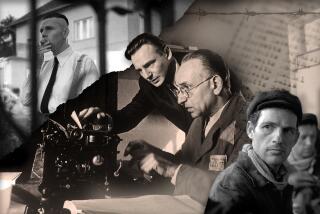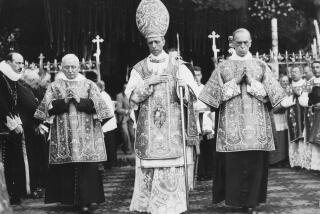Former Nazi Cited in Another Slaying : Holocaust Survivor Says He Saw Guard Machine-Gun Elderly Jew
- Share via
A survivor of a Nazi concentration camp in Austria on Monday identified a retired La Habra grocery clerk as the Nazi guard who machine-gunned to death an elderly Jew from Poland in 1945.
Alexsy Bialas, a retired soil engineer now living in Canada, fought back tears as he recounted how Bruno Karl Blach, 66, reportedly killed the feeble old man, an unidentified native of the Jewish ghetto in Warsaw who needed the aid of others to walk.
“I saw him (in a ditch) . . . ,” Bialas said in a quavering voice. “I can’t ever forget. The old chap was looking at me when he died. He was moving his lips. . . . I can’t talk about it. I’ll never forget. . . .”
He then bowed his head in silence.
Bialas testified in U.S. Immigration Court that while inmates of the Wiener-Neudorf concentration camp were on a forced march to escape advancing Soviet troops, a uniformed Nazi guard and dog handler, who he said was Blach, pulled the old man out of line without warning, hurled him into a nearby ditch and then machine-gunned him to death.
The testimony was the first eyewitness account during deportation proceedings against Blach that has linked him directly to Nazi atrocities during World War II. Last week, an expert in Nazi history read from a German history book a passage that identified a “Mr. Blach” as one of three SS guards who stomped two prisoners to death.
Blach is accused of lying about his service with the Nazi SS at the Dachau and Wiener-Neudorf concentration camps.
Lawyers with the U.S. Justice Department’s Office of Special Investigations contend that Blach, a native of Czechoslovakia, hid his Nazi past to get permission to emigrate to this country in 1956. He had been denied entry because of his Nazi background when he tried to come to the United States in 1951 under provisions of the Displaced Persons Act.
Blach’s attorney, Ronald Parker of Fullerton, has conceded that his client was a Nazi prison guard but has consistently denied that he was guilty of any mistreatment of prisoners.
“We’re not saying that the events didn’t happen, but we categorically deny that he was involved,” Parker said.
Bialas also testified that it was “common knowledge” among the Wiener-Neudorf prisoners that Blach killed others there, but he acknowledged that he had not personally seen any of the other alleged killings.
He said that he was arrested by the Nazis for smuggling arms to the Polish underground while a music student in his hometown in Poland in early 1942.
He later escaped from the forced march during which the elderly Jewish man was killed and made contact with Allied forces, he said.
Bialas did not point out Blach in the courtroom Monday, but he picked an old visa photo of Blach out of a photo spread put together by the prosecution. He first identified Blach for authorities in 1983, he said, when Canadian and American officials interviewed him about his concentration camp experiences and showed him eight photographs, among them Blach’s.
During cross-examination, Parker asked Bialas, who now lives in Niagara Falls, Canada, if he was sure after 41 years that Blach was indeed the Nazi guard who shot the old man to death.
“Yes, I am sure, sir,” Bialas replied. “I can (still) see this face.”
The hearing is expected to conclude today
More to Read
Sign up for Essential California
The most important California stories and recommendations in your inbox every morning.
You may occasionally receive promotional content from the Los Angeles Times.













